About the Feast of the Annunciation of Ever-Virgin Mary (March 25)
" Chronia polla! Many years! Munoga yayeta! Imyaka myinshi to all especially those who bear the names Evangelos, Evangelia, from BUJUMBURA BURUNDI..." (from here - about Orthodox Church in Burundi, here)
Father Thomas J. Paris (*)
Greek Orthodox Archdiocese of America
"My Soul Magnifies the Lord"
Do You Want to Know a Secret?
I have a secret that I would like to share with you. One might call it "an open" secret, but many people have stumbled because they ignored the truths in this secret. They have led sad, unfulfilled and many times wasted lives because they didn't implement the wisdom hidden in this secret.
Here's the secret. Hush; bend your ear close so that you will hear clearly. The secret of a happy, joy-filled life is a grateful heart. Without a heart filled with gratitude there is never a possibility of a life of happiness.
As we celebrate the Annunciation, we remember the earth-shaking news that God is taking on flesh. The Second Person of the Trinity, the Son of God, is going to enter the world as one of His creatures, to unite Himself with us, so that we can ultimately be united with God the Father.
It is a day that stumps the imagination. How? Why? Could God really do something like this? Could He actually become man and still remain God? What does that do to us? How does it change our future, yours and mine?
"My Soul Magnifies the Lord and my spirit has rejoiced in God my Savior." (Luke 1:46,47) is a paean gushing forth from a heart filled to overflowing with gratitude. It is the opening lines of the Magnificat sung by The Panagia, the Mother of God after hearing the following words from her cousin Elizabeth:
"Blessed are you among women, and blessed is the fruit of your womb, but why is this granted to me, that the mother of my Lord should come to me?" (Luke 1:42)
The young teenage woman was truly overwhelmed by the message brought to her by the Archangel Gabriel. "How can this be, since I do not know a man?" The Archangel's reply was both comforting and yet overwhelming. "For, with God nothing will be impossible."
And Mary's response was the culmination of humankind's long effort to
accomplish. Mary on behalf of all humans gives the one response that is
needed from all of us. Yes Lord, I want to serve you. I do accept your
offer of love. Change me so that I can be a clean vessel carrying you
within me. Let the miracle of your birth in time transform mortals into
timelessness.
Mary's song of bursting praise is the manifestation of a heart filled with gratitude and thanksgiving. As we learn from the Orthodox Study Bible Mary knew her Scripture. The Bible was her inspiration and guide. "My soul magnifies the Lord" was a hymn first offered by Hannah who in her advanced years uttered this inspired prayer (1 Samuel 2:1-10). It was prayed by expectant Jewish mothers for centuries.
Her words echo thanksgiving and gratitude:
"He has regarded the lowly state of His maidservant; For behold, henceforth all generations will call me blessed. For He who is mighty has done great things for me, and holy is His name. And His mercy is on those who fear Him from generation to generation."
Now this was not the only response that Mary could have given to the announcement from the Archangel and the words of Elizabeth.
She could have said, "Thanks, but no thanks. I really don't want to be a spectacle carrying a child under these strange circumstances. I don't need all that pressure on me to try to live up to some high standard that will curtail my activities, restrain my play, exercise program and entertainment. I don't have time to raise a child. I don't have the financial means, for I am so over my head in debt already. I didn't ask for this honor. Give it to someone else. Why is it always me who is given the difficult problems? How come Miss 'so and so' gets off so easy and I am the one saddled with a child. I have so much more to experience in life before I need to take on the responsibilities of motherhood? Why poor me! "
Yes Mary could have responded in this or some other negative way, but thankfully she didn't. She knew intuitively that a life of complaining, dissatisfaction, resentment, jealousy, grumbling and lament never brings happiness. Nor does resignation or indifference.
Happiness comes not when we reluctantly accept a new situation, a burdensome challenge or difficult responsibility, but when we embrace it and thank God for the opportunity to grow. Mary did not simply resign herself to her fate. She saw God acting, God loving, God offering, and she whole-heartedly embraced the new reality and burst into a song of praise and thanksgiving. She found true happiness in a life filled with gratitude.
Mary, the Theotokos, remains a model for all generations. She is the "Canon" the Rule or Measure by which all of us are to gauge our lives. She said Yes to God's offer of love. She gratefully worshipped and thanked Him. May we be wise enough to do the same.
Amen.
(*) Protopresbyter Thomas J. Paris has served as Dean of the Greek Orthodox Cathedral of the Ascension for the past thirty-three years. He is founder and co-chair of the Metropolis Spiritual Renewal Ministry and author of a six-year Bible Study on the Old and New Testaments. He organizes and conducts yearly Retreats for Teenagers and adults. He is a Graduate of Holy Cross Theological School and the Theological School of the University of Athens.
The Feast of the Annunciation of Our Most Holy Lady, the Theotokos and Ever-Virgin Mary is celebrated on March 25 each year. The Feast commemorates the announcement by the Archangel Gabriel to the Virgin Mary that our Lord and Savior Jesus Christ, the Son of God, would become incarnate and enter into this world through her womb.
The biblical story of the Feast of the Annunciation is found in the first chapter of the Gospel of Luke (1:26-39). The Archangel Gabriel appeared to the Virgin Mary, who was living in Nazareth, and said to her, “Hail, O favored one, the Lord is with you.” Mary was perplexed and wondered what kind of greeting this was.
The angel told her not to be afraid, for she had found favor with God. He said, “You will conceive in your womb and bear a son, and you shall call his name Jesus. He will be great and will be called the Son of the Most High; and the Lord God will give to him the throne of his father David, and he will reign over the house of Jacob forever; and of his kingdom there will be no end.”
Mary responded to the angel by asking how this could happen since she had no husband. The angel told her that the Holy Spirit and the power of God would come upon her, and that the child to be born of her would be called holy, the “Son of God.”
The angel then proceeded to tell the Virgin Mary that her cousin Elizabeth had conceived a son in her old age (John the Baptist), and affirmed that with God nothing is impossible.
In faith and obedience to the will of God, Mary replied to the angel, “Behold, I am the handmaid of the Lord; let it be according to your word.” Upon her response, the angel departed.
It is on the Feast of the Annunciation, that Orthodox Christians commemorate both the divine initiative of God, whereby He took on flesh from the Virgin for our salvation, and the human response, whereby Mary freely accepted the vocation offered to her. He elected to become man, and He desired to do this with the willing agreement of her whom He chose as His mother. Mary could have refused, for she was not a passive instrument, but an active participant with a free and positive part to play in God’s plan for our salvation. Thus, when on this and other feasts the Orthodox Church honors the Theotokos, the Mother of God, it is not just because God chose her but also because she herself chose to follow His will.
The icon of the Annunciation is one that presents the joy of the announcement of the coming of Christ. It is an icon of bright colors, depicting the Archangel Gabriel (1), who has descended from heaven, and the Virgin Mary (2), who has been chosen to be the Mother of God.
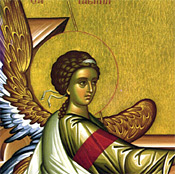
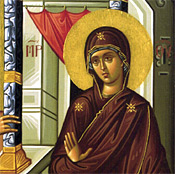
The Archangel is shown with his feet spread apart as if he is running
to share the good news with Mary (3). In his left hand is a staff, the
symbol of a messenger. His right hand is extended toward Mary as he
delivers the message and announces the blessing bestowed upon her by God
(4).
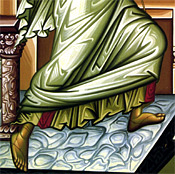
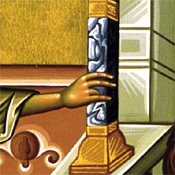
On the right side of the icon the Virgin sits on an elevated seat, indicating that as the Mother of God she is “greater in honor than the cherubim, and beyond compare more glorious than the seraphim, who without corruption gave birth to God the Word.” In her left hand she holds a spindle of scarlet yarn (5) which depicts the task she was assigned of preparing the purple and scarlet material to be used in making the veil for the Temple in Jerusalem. Her right hand is raised in a gesture of acceptance in response to Gabriel’s message (6). Her posture expresses willing cooperation with God’s plan of salvation. The three stars on her garments (7) represent that she was a Virgin before, during, and after the birth of Christ.
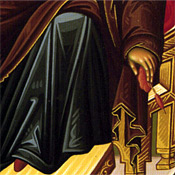
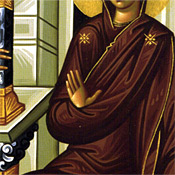

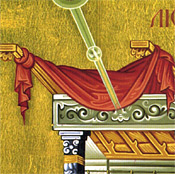
At the top of the icon the segment of a circle represents the divine realm (8), from which three rays emerge. This demonstrates the action of the Holy Spirit coming upon her.
The Feast of the Annunciation of the Theotokos is celebrated with the Divine Liturgy of Saint John Chrysostom which is conducted on the morning of the Feast and preceded by a Matins (Orthros) service. A Great Vespers is conducted on the evening before the day of the Feast. Scripture readings for the Feast are the following: At Vespers: Genesis 28:10-17; Ezekiel 43:27—44:4; Proverbs 9:1-11. At the Matins: Luke 1:39-49, 56. At the Divine Liturgy: Hebrews 2:11-18; Luke 1:24-38.
The Feast of the Annunciation in the Greek Orthodox Church also marks a day of national celebration for the people of Greece and those around the world of Greek descent. It was on March 25, 1821 when Greece officially declared its independence and began the revolution that would eventually give the nation its freedom after 400 years of rule by the Ottomans. In addition to the services for the Feast, festivities and parades are held and official proclamations are offered throughout the world in recognition of Greek Independence Day.
Festival Icons for the Christian Year by John Baggley (Crestwood, NY: St. Vladimir's Seminary Press, 2000), pp. 21-30.
The Festal Menaion. Translated by Mother Mary (South Canaan, PA: St. Tikhon’s Seminary Press, 1969) pp. 60-61.
The Incarnate God: The Feasts of Jesus Christ and the Virgin Mary, Catherine Aslanoff, editor and Paul Meyendorff, translator (Crestwood, NY: St. Vladimir’s Seminary Press, 1995).
The Life of the Virgin Mary, The Theotokos, written and compiled by Holy Apostles Convent (Buena Vista, CO: 1989).
The Synaxarion: The Lives of the Saints of the Orthodox Church, Vol. 4, compiled by Hieromonk Makarios of Simonos Petra and translated from the French by Mother Maria Rule and Mother Joanna Burton (Chalkidike, Greece: Holy Convent of the Annunciation of Our Lady, 2003) pp. 227-232.
Apolytikion (Fourth Tone)
Today marks the crowning of our salvation and the revelation of the mystery before all ages. For the Son of God becomes the son of the Virgin, and Gabriel proclaims the grace. Wherefore, we also cry out with him, "Hail, O full of grace, the Lord is with you."
Kontakion (Plagal of the Fourth Tone)
To you, Theotokos, invincible Defender, having been delivered from peril, I, your city, dedicate the victory festival as a thank offering. In your irresistible might, keep me safe from all trials, that I may call out to you: "Hail, unwedded bride!"
Listen to the hymns from the Feast of the Annunciation of the Theotokos
See also
More about the orthodox christian icon of the Annunciation of the Theotokos
Mother of God (Virgin Mary), Orthodox Church and African peoples (& Why the Orthodox Honor Mary)
Bikira Maria, Mama wa Mungu
Maria in die Ortodoksie
When the Orthodox Church celebrates pregnancy...
Theotokos (tag in our blog)
- See more at: http://www.johnsanidopoulos.com/2014/11/entrance-of-theotokos-resource-page.html#sthash.kErn0BI5.dpuf
- See more at: http://www.johnsanidopoulos.com/2014/11/entrance-of-theotokos-resource-page.html#sthash.kErn0BI5.dpuf
Synaxis of the Holy Archangel Gabriel (March 26)
I have a secret that I would like to share with you. One might call it "an open" secret, but many people have stumbled because they ignored the truths in this secret. They have led sad, unfulfilled and many times wasted lives because they didn't implement the wisdom hidden in this secret.
Here's the secret. Hush; bend your ear close so that you will hear clearly. The secret of a happy, joy-filled life is a grateful heart. Without a heart filled with gratitude there is never a possibility of a life of happiness.
As we celebrate the Annunciation, we remember the earth-shaking news that God is taking on flesh. The Second Person of the Trinity, the Son of God, is going to enter the world as one of His creatures, to unite Himself with us, so that we can ultimately be united with God the Father.
It is a day that stumps the imagination. How? Why? Could God really do something like this? Could He actually become man and still remain God? What does that do to us? How does it change our future, yours and mine?
"My Soul Magnifies the Lord and my spirit has rejoiced in God my Savior." (Luke 1:46,47) is a paean gushing forth from a heart filled to overflowing with gratitude. It is the opening lines of the Magnificat sung by The Panagia, the Mother of God after hearing the following words from her cousin Elizabeth:
"Blessed are you among women, and blessed is the fruit of your womb, but why is this granted to me, that the mother of my Lord should come to me?" (Luke 1:42)
The young teenage woman was truly overwhelmed by the message brought to her by the Archangel Gabriel. "How can this be, since I do not know a man?" The Archangel's reply was both comforting and yet overwhelming. "For, with God nothing will be impossible."
 |
| Icon from the site |
Mary's song of bursting praise is the manifestation of a heart filled with gratitude and thanksgiving. As we learn from the Orthodox Study Bible Mary knew her Scripture. The Bible was her inspiration and guide. "My soul magnifies the Lord" was a hymn first offered by Hannah who in her advanced years uttered this inspired prayer (1 Samuel 2:1-10). It was prayed by expectant Jewish mothers for centuries.
Her words echo thanksgiving and gratitude:
"He has regarded the lowly state of His maidservant; For behold, henceforth all generations will call me blessed. For He who is mighty has done great things for me, and holy is His name. And His mercy is on those who fear Him from generation to generation."
Now this was not the only response that Mary could have given to the announcement from the Archangel and the words of Elizabeth.
She could have said, "Thanks, but no thanks. I really don't want to be a spectacle carrying a child under these strange circumstances. I don't need all that pressure on me to try to live up to some high standard that will curtail my activities, restrain my play, exercise program and entertainment. I don't have time to raise a child. I don't have the financial means, for I am so over my head in debt already. I didn't ask for this honor. Give it to someone else. Why is it always me who is given the difficult problems? How come Miss 'so and so' gets off so easy and I am the one saddled with a child. I have so much more to experience in life before I need to take on the responsibilities of motherhood? Why poor me! "
Yes Mary could have responded in this or some other negative way, but thankfully she didn't. She knew intuitively that a life of complaining, dissatisfaction, resentment, jealousy, grumbling and lament never brings happiness. Nor does resignation or indifference.
Happiness comes not when we reluctantly accept a new situation, a burdensome challenge or difficult responsibility, but when we embrace it and thank God for the opportunity to grow. Mary did not simply resign herself to her fate. She saw God acting, God loving, God offering, and she whole-heartedly embraced the new reality and burst into a song of praise and thanksgiving. She found true happiness in a life filled with gratitude.
Mary, the Theotokos, remains a model for all generations. She is the "Canon" the Rule or Measure by which all of us are to gauge our lives. She said Yes to God's offer of love. She gratefully worshipped and thanked Him. May we be wise enough to do the same.
Amen.
(*) Protopresbyter Thomas J. Paris has served as Dean of the Greek Orthodox Cathedral of the Ascension for the past thirty-three years. He is founder and co-chair of the Metropolis Spiritual Renewal Ministry and author of a six-year Bible Study on the Old and New Testaments. He organizes and conducts yearly Retreats for Teenagers and adults. He is a Graduate of Holy Cross Theological School and the Theological School of the University of Athens.
The Feast of the Annunciation of Our Most Holy Lady, the Theotokos
and Ever-Virgin Mary
Introduction
The Feast of the Annunciation of Our Most Holy Lady, the Theotokos and Ever-Virgin Mary is celebrated on March 25 each year. The Feast commemorates the announcement by the Archangel Gabriel to the Virgin Mary that our Lord and Savior Jesus Christ, the Son of God, would become incarnate and enter into this world through her womb.
Biblical Story
The biblical story of the Feast of the Annunciation is found in the first chapter of the Gospel of Luke (1:26-39). The Archangel Gabriel appeared to the Virgin Mary, who was living in Nazareth, and said to her, “Hail, O favored one, the Lord is with you.” Mary was perplexed and wondered what kind of greeting this was.
The angel told her not to be afraid, for she had found favor with God. He said, “You will conceive in your womb and bear a son, and you shall call his name Jesus. He will be great and will be called the Son of the Most High; and the Lord God will give to him the throne of his father David, and he will reign over the house of Jacob forever; and of his kingdom there will be no end.”
Mary responded to the angel by asking how this could happen since she had no husband. The angel told her that the Holy Spirit and the power of God would come upon her, and that the child to be born of her would be called holy, the “Son of God.”
The angel then proceeded to tell the Virgin Mary that her cousin Elizabeth had conceived a son in her old age (John the Baptist), and affirmed that with God nothing is impossible.
In faith and obedience to the will of God, Mary replied to the angel, “Behold, I am the handmaid of the Lord; let it be according to your word.” Upon her response, the angel departed.
It is on the Feast of the Annunciation, that Orthodox Christians commemorate both the divine initiative of God, whereby He took on flesh from the Virgin for our salvation, and the human response, whereby Mary freely accepted the vocation offered to her. He elected to become man, and He desired to do this with the willing agreement of her whom He chose as His mother. Mary could have refused, for she was not a passive instrument, but an active participant with a free and positive part to play in God’s plan for our salvation. Thus, when on this and other feasts the Orthodox Church honors the Theotokos, the Mother of God, it is not just because God chose her but also because she herself chose to follow His will.
Icon of the Feast
The icon of the Annunciation is one that presents the joy of the announcement of the coming of Christ. It is an icon of bright colors, depicting the Archangel Gabriel (1), who has descended from heaven, and the Virgin Mary (2), who has been chosen to be the Mother of God.

1. The Archangel Gabriel presents the good news of the coming of Christ to Mary (detail).

2. The Virgin Mary, who was chosen to be the Mother of God (detail).

3. The position of Archangel Gabriel's feet suggest that he is running to share the news with Mary (detail).

4. The Archangel's right hand is extended towards Mary as he announces the blessing bestowed upon her [Mary] by God (detail).
On the right side of the icon the Virgin sits on an elevated seat, indicating that as the Mother of God she is “greater in honor than the cherubim, and beyond compare more glorious than the seraphim, who without corruption gave birth to God the Word.” In her left hand she holds a spindle of scarlet yarn (5) which depicts the task she was assigned of preparing the purple and scarlet material to be used in making the veil for the Temple in Jerusalem. Her right hand is raised in a gesture of acceptance in response to Gabriel’s message (6). Her posture expresses willing cooperation with God’s plan of salvation. The three stars on her garments (7) represent that she was a Virgin before, during, and after the birth of Christ.

5. Her left hand holds a spindle of
crimson yarn depicting the task that she had of making the veil of the
Temple in Jerusalem (detail).

6. Mary's right hand is raised in acceptance of Gabriel's message (detail).

7. The three stars on the garments of
the Theotokos represent that she was a Virgin before, during, and after
the birth of Christ (detail).

8. A depiction of the divine realm and the Holy Spirit coming upon the Theotokos (detail).
At the top of the icon the segment of a circle represents the divine realm (8), from which three rays emerge. This demonstrates the action of the Holy Spirit coming upon her.
Orthodox Christian Celebration of the Feast of the Annunciation of the Theotokos
The Feast of the Annunciation of the Theotokos is celebrated with the Divine Liturgy of Saint John Chrysostom which is conducted on the morning of the Feast and preceded by a Matins (Orthros) service. A Great Vespers is conducted on the evening before the day of the Feast. Scripture readings for the Feast are the following: At Vespers: Genesis 28:10-17; Ezekiel 43:27—44:4; Proverbs 9:1-11. At the Matins: Luke 1:39-49, 56. At the Divine Liturgy: Hebrews 2:11-18; Luke 1:24-38.
The Feast of the Annunciation in the Greek Orthodox Church also marks a day of national celebration for the people of Greece and those around the world of Greek descent. It was on March 25, 1821 when Greece officially declared its independence and began the revolution that would eventually give the nation its freedom after 400 years of rule by the Ottomans. In addition to the services for the Feast, festivities and parades are held and official proclamations are offered throughout the world in recognition of Greek Independence Day.
Resources
Festival Icons for the Christian Year by John Baggley (Crestwood, NY: St. Vladimir's Seminary Press, 2000), pp. 21-30.
The Festal Menaion. Translated by Mother Mary (South Canaan, PA: St. Tikhon’s Seminary Press, 1969) pp. 60-61.
The Incarnate God: The Feasts of Jesus Christ and the Virgin Mary, Catherine Aslanoff, editor and Paul Meyendorff, translator (Crestwood, NY: St. Vladimir’s Seminary Press, 1995).
The Life of the Virgin Mary, The Theotokos, written and compiled by Holy Apostles Convent (Buena Vista, CO: 1989).
The Synaxarion: The Lives of the Saints of the Orthodox Church, Vol. 4, compiled by Hieromonk Makarios of Simonos Petra and translated from the French by Mother Maria Rule and Mother Joanna Burton (Chalkidike, Greece: Holy Convent of the Annunciation of Our Lady, 2003) pp. 227-232.
Hymns of the Feast of the Annunciation
Apolytikion (Fourth Tone)
Today marks the crowning of our salvation and the revelation of the mystery before all ages. For the Son of God becomes the son of the Virgin, and Gabriel proclaims the grace. Wherefore, we also cry out with him, "Hail, O full of grace, the Lord is with you."
Kontakion (Plagal of the Fourth Tone)
To you, Theotokos, invincible Defender, having been delivered from peril, I, your city, dedicate the victory festival as a thank offering. In your irresistible might, keep me safe from all trials, that I may call out to you: "Hail, unwedded bride!"
Listen to the hymns from the Feast of the Annunciation of the Theotokos
See also
More about the orthodox christian icon of the Annunciation of the Theotokos
Mother of God (Virgin Mary), Orthodox Church and African peoples (& Why the Orthodox Honor Mary)
Bikira Maria, Mama wa Mungu
Maria in die Ortodoksie
Theotokos (tag in our blog)
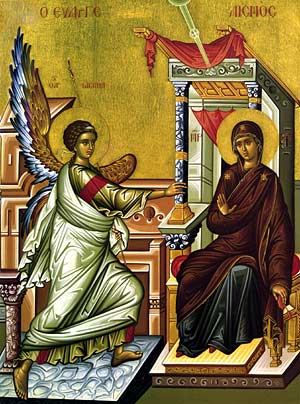




Δεν υπάρχουν σχόλια:
Δημοσίευση σχολίου